Grumman F9F Panther
| F9F Panther | |
|---|---|
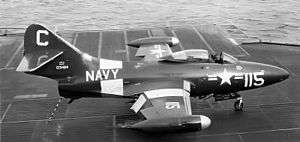 | |
| An F9F-2 of VF-21 aboard USS Midway in 1952 | |
| Role | Fighter-bomber |
| Manufacturer | Grumman |
| First flight | 21 November 1947 |
| Retired | 1958, U.S. Navy 1969, Argentina |
| Primary users | United States Navy United States Marine Corps Argentine Navy |
| Number built | 1,382 |
| Developed into | Grumman F-9 Cougar |
The Grumman F9F Panther is one of the United States Navy's first successful carrier-based jet fighters, as well as Grumman’s first jet fighter. A single-engined, straight-winged day fighter, it was armed with four 20 mm (0.79 in) cannons and could carry a wide assortment of air-to-ground munitions.
The Panther was used extensively by the U.S. Navy and Marine Corps in the Korean War. It was also the first jet aircraft used by the Blue Angels aerobatics demonstration team, from 1949 through late 1954. The aircraft was exported to Argentina and was the first jet used by the Argentine Naval Aviation.
Total F9F production was 1,382. The design evolved into the swept wing Grumman F-9 Cougar.
Design and development
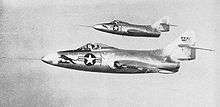
Development studies at Grumman for jet-powered fighter aircraft began near the end of World War II as the first jet engines emerged. In a competition for a jet-powered night fighter for the United States Navy, on 3 April 1946 the Douglas F3D Skyknight was selected over Grumman's G-75, a two-seater powered by four Westinghouse J30s. The Navy's Bureau of Aeronautics (BuAer) also issued a contract to Grumman for two G-75 prototype aircraft on 11 April 1946, being given the Navy designation XF9F-1, in case the Skyknight ran into problems.
Grumman soon realized the G-75 was a dead end, but had been working on a completely different, single-engine day fighter, the G-79. In a bureaucratic maneuver, BuAer did not cancel the G-75 contract, but changed the wording to include three prototypes of the entirely different G-79. It became the Panther.[1]
The prototype Panther, piloted by test pilot Corky Meyer, first flew on 21 November 1947.[2] American engines available at the time included the Allison J33 and Westinghouse J34, but these were not considered sufficiently reliable,[3] so the Navy specified the imported Rolls-Royce Nene turbojet, which was also more powerful, at 5,000 lb (2,300 kg) of thrust. Production aircraft would have a Nene, built under license by Pratt & Whitney as the J42. Since there was insufficient space within the wings and fuselage for fuel for the thirsty jet, permanently mounted wingtip fuel tanks were added, which incidentally improved the fighter's rate of roll.[4]
The F9F was cleared for flight from aircraft carriers in September 1949. During the development phase, Grumman decided to change the Panther's engine, selecting the Pratt & Whitney J48-P-2, a license built version of the Rolls-Royce RB.44 Tay. The other engine that had been tested was the Allison J33-A-16. The armament was a quartet of 20mm guns, the Navy having already switched to this caliber (as opposed to the USAAF/USAF which continued to use 12.7mm M2/M3 guns). As well, the Panther soon was armed with underwing air-to-ground rockets and up to 2,000 lb (910 kg) of bombs.
From 1946, a swept-wing version was considered and after concerns about the Panther's inferiority to its MiG opponents in Korea, a conversion, known as Design 93, resulted in a swept-wing derivative, the F9F Cougar, which retained the Panther's designation number.[5]
In 1949, the Panther was considered by the Australian government, as a possible locally-built replacement for the Mustang Mk 23 and De Havilland Vampire then operated by the Royal Australian Air Force (RAAF).[6] The other designs considered initially were an Australian design, the CAC CA-23 (an unconventional, twin-jet all-weather fighter) and the Hawker P.1081. By mid-1950, however, RAAF Mustangs were in action in Korea and seen as highly vulnerable to the MiG 15. An immediately available stop-gap in the shape of the Gloster Meteor F.8 was operated by the RAAF in Korea from July 1951. (After its less-than-satisfactory performance against MiGs, the Meteor was replaced from 1954 by the CAC Sabre – an Australian-built, up-engined variant of the F-86.[7])
Operational history
US Navy
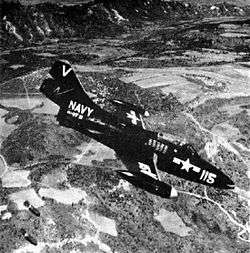
The Grumman Panther was the primary US Navy and USMC jet fighter and ground-attack aircraft in the Korean War. The Panther was the most widely used U.S. Navy jet fighter of the Korean War, flying 78,000 sorties and scoring the first air-to-air kill by the U.S. Navy in the war, the downing of a North Korean Yakovlev Yak-9 fighter. F9F-2s, F9F-3s and F9F-5s, as rugged attack aircraft, were able to sustain operations, even in the face of intense anti-aircraft fire. The pilots also appreciated the air conditioned cockpit, which was a welcome change from the humid environment of piston-powered aircraft.[8]
Despite their relative slow speed, Panthers also managed to shoot down two Yak-9s and seven Mikoyan-Gurevich MiG-15s for the loss of two F9Fs. On 3 July 1950, Lieutenant, junior grade Leonard H. Plog of U.S. Navy's VF-51 flying an F9F-3 scored the first U.S. Navy air victory of the war by shooting down a Yak-9.[9]
The first MiG-15 was downed on 9 November 1950 by Lieutenant Commander William (Bill) Amen of VF-111 "Sundowners" flying an F9F-2B. Two more MiG-15s were downed on 18 November 1950.
On 18 November 1952, Lt. Royce Williams of VF-781, flying off USS Oriskany destroyed four MiGs in a single, 35-minute combat. This unique feat has remained little-known, due to the involvement of National Security Agency (NSA) – the existence of which was then top secret – in planning the mission.[10] Following intelligence provided by the NSA, the MiGs had been intercepted during a series of air strikes against the North Korean port of Hoeryong. After losing contact with his wingman, Williams found himself alone in a dogfight with six MiG-15s; when he was able to land on Oriskany, his Panther was found to have sustained 263 hits from by cannon shells or fragments, and to be beyond repair. Williams' victories were even more notable in that all four MiGs were flown by Soviet Naval Aviation pilots: Russian sources confirmed Williams' claims, 40 years later, stating that the pilots lost were Captains Belyakov and Vandalov, and Lieutenants Pakhomkin and Tarshinov.
Future astronaut Neil Armstrong flew the F9F extensively during the war, even ejecting from one of the aircraft when it was brought down by a wire strung across a valley, in 1951. Future astronaut John Glenn and Boston Red Sox all-star baseball player Ted Williams also flew the F9F as Marine Corps pilots.
Panthers were withdrawn from front-line service in 1956, but remained in training roles and with U.S. Naval Air Reserve and U.S. Marine Air Reserve units until 1958. The Navy's Blue Angels flight demonstration team used the Panther for four years, beginning in 1951. The Panther was the Blue Angels' first jet.[11] Some Panthers continued to serve in small numbers into the 1960s.[12] From September 1962 surviving operational Panthers were redesignated F-9 within the new combined US tri-service designation system.[13]
Argentine Navy
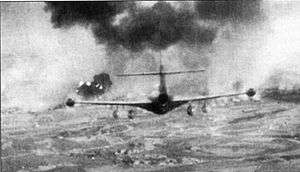
The only foreign buyer of the Panther was the Argentine Naval Aviation, which bought 28 ex-USN F9F-2B aircraft in 1957; the first 10 arrived in 1958. Only 24 aircraft were put in service, the rest were used as spares. The first flight of an Argentine Panther was in December 1958, and the last aircraft was put in service in January 1961.[14]
The catapults on the then only Argentine carrier, ARA Independencia, were considered not powerful enough to launch the F9F, so the aircraft were land-based. However, in July 1963 a Panther (serial 0453/3-A-119) landed on Independencia as part of trials; becoming the first jet to land on an Argentine aircraft carrier.[14]
Argentine Navy F9F-2 Panthers saw combat in the 1963 Argentine Navy Revolt, bombing and strafing a column of the Army 8th Tank Regiment which was advancing on the rebelling Punta Indio Naval Air Base. The attack destroyed several M4 Sherman tanks, at the cost of one F9F Panther shot down.[15]
The Argentine Panthers were involved in the general mobilization during the 1965 border clash between Argentina and Chile but no combat occurred. They were taken out of service in 1969 due to the lack of spare parts and replaced with Douglas A-4Q Skyhawks.[16]
The Argentine Navy also operated the F-9 Cougar.[14]
Variants
.jpg)
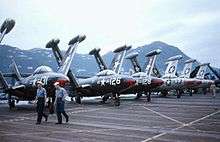
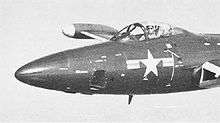

- XF9F-2
- The first two prototypes
- XF9F-3
- The third prototype
- F9F-2
- First production version, powered by Pratt & Whitney J42 engine.
- F9F-2B
- Version fitted with underwing racks for bombs and rockets. All F9F-2s were eventually so modified, and the B designation was dropped.
- F9F-2P
- Unarmed photographic reconnaissance version used in Korea.
- F9F-3
- Allison J33 powered version produced as insurance against the failure of the J42, 54 built. All converted to J42 power later.Redesignated F-9B in 1962.
- XF9F-4
- Prototype used in the development of the F9F-4.
- F9F-4
- Version with longer fuselage with greater fuel load and powered by J33 engine. Most re-engined with J42s. F9F-4s were the first aircraft to successfully employ pressurized bleed air, tapped from the engine's compressor stages, and blown across the surface of the slot flaps, simulating a higher airspeed across the control surface, and thus achieving a decrease in stalling speed of 9 kn for takeoff and 7 kn on power approach for landing.Redesignated F-9C in 1962.
- F9F-5
- Variant of F9F-4, but powered by Pratt & Whitney J48 engine, 616 built.Redesignated F-9D in 1962.
- F9F-5P
- Unarmed photo-reconnaissance version, 36 built, longer nose.Redesignated RF-9D in 1962.
- F9F-5K
- After the F9F Panther was withdrawn operational service, a number of F9F-5s were converted into unmanned target drone aircraft.Redesignated QF-9D in 1962.
- F9F-5KD
- As drone directors for the F9F-5K drones. Redesignated DF-9E in 1962.
Operators
Surviving aircraft
Argentina
- On display
- F9F-2B
- 0421/3-A-106 (Argentine Navy) - Gate guardian at Puerto Belgrano Naval Base (Base Naval Puerto Belgrano - BNPB) at Bahía Blanca, Argentina.[14]
- 0425/3-A-113 (Argentine Navy) - Being restored at Argentine Naval Aviation Museum (Museo de la Aviacion Naval - MUAN) at Bahía Blanca, Argentina.[14]
- 0452/3-A-111 (Argentine Navy) - Gate guardian at Punta Indio Naval Air Base (Base Aeronaval Punta Indio - BAPI) near La Plata, Argentina.[14]
- 0453/3-A-118 (Argentine Navy) - Displayed at National Naval Museum (Museo Naval de la Nación) at Tigre, Argentina.[14]
United States
- Airworthy
- F9F-2B
- 123078 Cavanaugh Flight Museum in Addison, Texas.[17][18]
- On display
.jpg)
- F9F-2
- 123050 - National Naval Aviation Museum at Naval Air Station Pensacola, Florida.[19]
- 123557 - VFW Post 1621 in Janesville, Wisconsin.[20]
- 123612 - NAS Oceana Air Park, Naval Air Station Oceana, Virginia.[21]
- 123652 - Flying Leatherneck Aviation Museum, Marine Corps Air Station Miramar, California.[22]
- 125183 - Pima Air & Space Museum, adjacent to Davis-Monthan AFB in Tucson, Arizona.[23]
- 127120 - Wings of Freedom Aviation Museum at the former NAS JRB Willow Grove in Horsham, Pennsylvania.[24]
- F9F-2B
- 123526 - National Museum of the Marine Corps, adjacent to Marine Corps Base Quantico in Triangle, Virginia.[25]
- F9F-4
- 125180 - Lion's Park in Costa Mesa, California.[26]
- F9F-5
- bureau number unknown (incorrectly marked as 141136) - USS Midway Museum in San Diego, California[27]
- 125295 - Valiant Air Command Warbird Museum at Space Coast Regional Airport in Titusville, Florida.[28]
- 125992 - Aviation Heritage Park in Bowling Green, KY.[29]
- 126226 - Combat Air Museum adjacent to Forbes Air National Guard Base at Topeka Regional Airport / Forbes Field (former Forbes AFB) in Topeka, Kansas.[30]
- 126275 - Battleship Memorial Park in Mobile, Alabama.[31]
- F9F-5P
- 126277 - The Air Museum, Planes of Fame, in Chino, California.[32]
- Under restoration or in storage
- F9F-2
- 123054 - under restoration at Yanks Air Museum in Chino, California.[33]
- 123092 - in storage for restoration at USS John F. Kennedy Museum in North Kingston, Rhode Island.[34]
- 123420 - in storage at Fantasy of Flight in Polk City, Florida.[35]
- F9F-5
- 125467 - in storage by Dale James in Bulverde, Texas.[36]
Specifications (F9F-2 Panther)
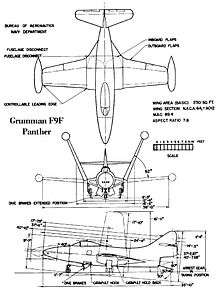
Data from
General characteristics
- Crew: 1
- Length: 37 ft 5 in (11.3 m)
- Wingspan: 38 ft 0 in (11.6 m)
- Height: 11 ft 4 in (3.8 m)
- Wing area: 250 ft² (23 m²)
- Empty weight: 9,303 lb (4,220 kg)
- Loaded weight: 14,235 lb (6,456 kg)
- Max. takeoff weight: 16,450 lb (7,462 kg)
- Powerplant: 1 × Pratt & Whitney J42-P-6/P-8 turbojet, 5,950 lbf (26.5 kN) with water injection
Performance
- Maximum speed: 500 kn (575 mph, 925 km/h)
- Range: 1,353 mi (1,175 nmi, 2,177 km)
- Service ceiling: 44,600 ft (13,600 m)
- Rate of climb: 5,140 ft/min (26.1 m/s)
- Wing loading: 71 lb/ft² (350 kg/m²)
- Thrust/weight: 0.42
Armament
- Guns: 4 × 20 mm (0.79 in) AN/M3 cannon, 190 rpg
- Hardpoints: Underwing hardpoints and provisions to carry combinations of:
- Rockets: 6 × 5 in (127 mm) rockets on underwing hardpoints
- Bombs: 2,000 lb (907 kg) of bombs
Notable appearances in media
See also
Related development
Aircraft of comparable role, configuration and era
Related lists
References
Notes
- ↑ Hardy 1987, p.79.
- ↑ Meyer 2002
- ↑ Noland, David. "Panther at sea, Air and Space, June/July 2013, p. 29
- ↑ Winchester 2004, p. 96.
- ↑ Taylor 1969, p. 506.
- ↑ RAAF Museum, 2009, A94 CAC Sabre (14 December 2012).
- ↑ RAAF Museum, 2009, A94 CAC Sabre
- ↑ Noland, David, Panthers at sea, Air & Space, June/July 2013, pp. 30-31
- ↑ Kott 2007, p. 293.
- ↑ Cleaver, Thomas M. "Four Down! The Korean Combat the U.S. Tried to Forget." Flight Journal, June 2013, pp. 42–49.
- ↑ Noland, David, Panthers at sea, Air & Space, June/July 2013, p.35
- ↑ Winchester 2004, p. 97.
- ↑ Danby, 1977, p.57
- ↑ Cooper, Tom. "Argentina, 1955-1965." ACIG.org. Retrieved: 24 January 2013.
- ↑ Mey, Carlos. ."Panther" (in Spanish). Pictorial and history in Argentine service. Retrieved: 19 July 2011.
- ↑ "FAA Registry: N9525A." faa.gov Retrieved: 21 January 2015.
- ↑ "F9F Panther/123078" Archived March 17, 2015, at the Wayback Machine. Cavanaugh Flight Museum. Retrieved: 21 January 2015.
- ↑ "F9F Panther/123050". National Naval Aviation Museum. Retrieved: 15 January 2015.
- ↑ "F9F Panther/123557" aerialvisuals.ca Retrieved: 15 January 2015.
- ↑ "F9F Panther/123612". aerialvisuals.ca Retrieved: 8 April 2015.
- ↑ "F9F Panther/123653". Flying Leatherneck Aviation Museum Retrieved: 15 January 2015.
- ↑ "F9F Panther/125183". Pima Air & Space Museum. Retrieved: 15 January 2015.
- ↑ "F9F Panther/127120" Wings of Freedom Museum. Retrieved: 15 January 2015.
- ↑ "F9F Panther/123526." Archived July 19, 2009, at the Wayback Machine. National Museum of the Marine Corps. Retrieved: 2 February 2013.
- ↑ "F9F Panther/125180". aerialvisuals.ca Retrieved: 1 June 2014.
- ↑ "F9F Panther/unknown" USS Midway Museum. Retrieved: 15 January 2015.
- ↑ "F9F Panther/125295". Valiant Air Command Museum. Retrieved: 15 January 2015.
- ↑ "F9F Panther/125992".Aviation Heritage Park. Retrieved: 29 December 2016.
- ↑ "F9F Panther/126226". Combat Air Museum. Retrieved: 4 March 2013.
- ↑ "F9F Panther/126275". Archived 2015-12-18 at the Wayback Machine. Battleship Memorial Park. Retrieved: 15 January 2015.
- ↑ "F9F Panther/126277." Planes of Fame Air Museum. Retrieved: 10 November 2012.
- ↑ "F9F Panther/123054." Archived 2015-09-07 at the Wayback Machine. Yanks Air Museum. Retrieved: 21 January 2015.
- ↑ "F9F Panther/123092." USS JFK Museum. Retrieved: 21 January 2015.
- ↑ "FAA Registry: N32313." faa.gov Retrieved: 21 January 2015.
- ↑ "FAA Registry: N1332F." faa.gov Retrieved: 21 January 2015.
Bibliography
- Danby, Peter A. United States Navy Serials 1941 to 1976. Merseyside Aviation Society, Liverpool, England, 1977. ISBN 0-902420-17-8.
- Grossnick, Roy and William J. Armstrong. United States Naval Aviation, 1910-1995. Annapolis, Maryland: Naval Historical Center, 1997. ISBN 0-16-049124-X.
- Hardy, Michael John. Sea, Sky and Stars: An Illustrated History of Grumman Aircraft. London: Arms & Armour Press, 1987. ISBN 978-0853688327.
- Kott, Richard C. "Attack from the Sky". in Marolda, Edward (ed.). The United States Navy in the Korean War. Annapolis, Maryland: Naval Institute Press, 2007. ISBN 978-1591144878.
- Meyer, Corwin H. "Grumman Panther". Flight Journal, October 2002.
- Schnitzer, George. Panthers Over Korea. Baltimore, Maryland: Publish America, 2007. ISBN 1-4241-7942-4.
- Sullivan, Jim. F9F Panther/Cougar in action. Carrollton, Texas: Squadron/Signal Publications, 1982. ISBN 978-0-89747-127-5.
- Taylor, John W.R. "Grumman F9F Cougar". Combat Aircraft of the World from 1909 to the Present. New York: G.P. Putnam's Sons, 1969. ISBN 0-425-03633-2.
- Winchester, Jim, ed. "Grumman F9F Panther". Military Aircraft of the Cold War (The Aviation Factfile). London: Grange Books plc, 2006. ISBN 1-84013-929-3.
Online sources
- Cicalesi, Juan Carlos; Rivas, Santiago (22 December 2008). "Grumman Panther en Argentina" [Grumman Panther in Argentina]. Instituto Aeronaval - Articulos - Historia (in Spanish). Instituto Aeronaval. Archived from the original on 29 October 2014. Retrieved 2014-08-28.
- Carlos Mey (ed.). "CAZA BOMBARDEROS DE LA AVIACION NAVAL - Grumman F9F-2 Panther" [Naval Aviation Fighter-bombers - Grumman F9F-2 Panther]. Histarmar - Historia y Arqueologia Marítima (in Spanish). FUNDACION HISTARMAR. Retrieved 2014-08-29.
Further reading
- Meyer, Corwin (2003). GRUMMAN F9F PANTHER PART ONE – Development, Testing, Structures. Naval Fighters. Nº59 (First ed.). California, United States: Ginter Books. ISBN 0-942612-59-0. Retrieved 31 January 2015.
- Ginter, Steve (2003). GRUMMAN F9F PANTHER PART TWO – USMC Panthers (Includes Blue Angels, Reserves and Argentina). Naval Fighters. Nº60 (First ed.). California, United States: Ginter Books. ISBN 0-942612-60-4. Retrieved 31 January 2015.
- Ginter, Steve (2003). GRUMMAN F9F PANTHER PART 3 – NAVY Panthers (Korea and Beyond). Naval Fighters. Nº61 (First ed.). California, United States: Ginter Books. ISBN 0-942612-61-2. Retrieved 31 January 2015.
- Núñez Padin, Jorge Felix (2010). Núñez Padin, Jorge Felix, ed. Grumman F9F Panther & Cougar. Serie Aeronaval (in Spanish). 29. Bahía Blanca, Argentina: Fuerzas Aeronavales. ISBN 978-987-1682-03-4. Archived from the original on 2015-01-06. Retrieved 2014-08-26.
External links
| Wikimedia Commons has media related to Grumman F9F Panther. |